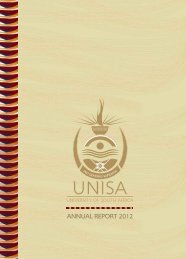pdf: 6.426kb - University of South Africa
pdf: 6.426kb - University of South Africa
pdf: 6.426kb - University of South Africa
You also want an ePaper? Increase the reach of your titles
YUMPU automatically turns print PDFs into web optimized ePapers that Google loves.
neously, usually letting the owner <strong>of</strong> the house take<br />
the lead by allowing his voice to be heard over the<br />
others. It is not unusual that rivalries will occur at<br />
this point, when somebody tries to show more<br />
power than others through the icaros. When a<br />
vegetalista has disciples, it may happen that they<br />
will follow the icaro <strong>of</strong> the teacher. It is believed<br />
that an icaro sung by several people will have a<br />
stronger effect.<br />
Many people report hearing marvellous music.<br />
The spirits come singing, and in fact the singing <strong>of</strong><br />
the vegetalista is orchestrated by the music and<br />
chorus <strong>of</strong> the spirits. From time to time there are<br />
breaks in the singing, and the vegetalista and other<br />
people are in deep concentration contemplating<br />
their visions. People <strong>of</strong>ten have periods <strong>of</strong> heavy<br />
vomiting and diarrhoea. When the vegetalista is<br />
`bien mareado' [very dizzy] he will call the patients<br />
one by one and cure them, usually by blowing<br />
smoke on their bodies to restore their lost spirits, by<br />
rubbing them with special stones called encantos<br />
[enchanted objects], or by sucking the inflicted<br />
part. If the matter in question is love magic, a<br />
photograph <strong>of</strong> the person is brought so that the<br />
vegetalista will act on it. Sometimes only the name<br />
and address will suffice for the vegetalista to<br />
perform some action over the distant person.<br />
Shamanic fights are not infrequent. The vegetalista<br />
may realize that he is under attack by the witch<br />
or the forces that caused illness. He will then sing<br />
special songs which will bring his arcanas (defences)<br />
and tingunas to his defence. It may happen<br />
that a person is frightened by the visions, and the<br />
vegetalista has to `take out his visions' with an<br />
icaro, or by blowing smoke on the top <strong>of</strong> the<br />
person's head, rubbing his body, and such. When<br />
everything seems to be at peace, and there are<br />
beautiful visions, it may happen that the persons<br />
taking part in the session will dance. Musical<br />
instruments are sometimes used in sessions.<br />
After several hours the vegetalista finally keeps<br />
silent, and people may sleep on the spot or tell<br />
stories in the dark. Patients may stay there until the<br />
morning, or leave the place after they have been<br />
healed.<br />
Vegetalismo and Healing<br />
We have already seen that vegetalismo is still a very<br />
active practice in the Peruvian Amazon. Wils<br />
(1967:131) found that over 25 per cent <strong>of</strong> the people<br />
he questioned in Bele n, Iquitos, preferred empõÂricos<br />
(folk healers) to Western doctors. Dobkin de Rios<br />
(1984:67) sees this as a conservative figure. I went to<br />
several healing sessions with my informants in various<br />
parts <strong>of</strong> Iquitos and the RõÂ o Napo area, and found<br />
many people attending these ceremonies. In one<br />
ceremony with Don Herman, on the outskirts <strong>of</strong><br />
Iquitos, there were twenty-two people in attendance.<br />
Most <strong>of</strong> my informants in the RõÂo Napo area, as<br />
previously stated, had an average <strong>of</strong> ten patients per<br />
week, and in Iquitos, up to ten patients per day.<br />
Dobkin de Rios (1984:82) found that the destitute<br />
who live in Bele n, find the ayahuasca healer far more<br />
effective than the indifferent medical services available<br />
to them. Vegetalistas, due to their possession <strong>of</strong> an<br />
intimate understanding <strong>of</strong> the social community in<br />
which they are immersed, and their pr<strong>of</strong>iciency in the<br />
use <strong>of</strong> medicinal plants and healing metaphors,<br />
contribute significantly to the physical and mental<br />
health <strong>of</strong> the people <strong>of</strong> rural areas and the urban poor<br />
(Luna 1991:13). While the ayahuasquero gears his<br />
prices to the ability <strong>of</strong> his patient to pay, the large city<br />
hospital's public wards provide no medical service<br />
inexpensive enough for the empty pockets <strong>of</strong> the<br />
poor. Formal medical consultations are generally far<br />
too costly for poor people, and the city hospital has<br />
the reputation <strong>of</strong> being a place that the poor go to in<br />
order to die (Dobkin de Rios 1984:78±82).<br />
The medical clinics and <strong>of</strong>fices are totally foreign<br />
and even sometimes terrifyingly alien, especially to the<br />
rural mestizos. The Western doctors usually have very<br />
little time and charge too much. The vegetalista <strong>of</strong>ten<br />
opens his home to the patients, even for long periods<br />
<strong>of</strong> time, provides counselling, shows interest in the<br />
financial and emotional problems <strong>of</strong> his patients,<br />
amuses them with his stories, even <strong>of</strong>fers them what<br />
we would call forms <strong>of</strong> family therapy (Luna<br />
1986:161).<br />
Don Fernando, one <strong>of</strong> my informants, went for a<br />
week to a village close to Iquitos, where he treated<br />
two <strong>of</strong> his patients. He stayed there all the time giving<br />
plant remedies, emotional and spiritual support, only<br />
in exchange for the cost <strong>of</strong> his transport by colectivo<br />
(river boat) and free accommodation and food. In<br />
other healing ceremonies, I have noticed that some<br />
patients will give the vegetalista fish, yucca, mapachos<br />
(native cigarettes) or other kind <strong>of</strong> produce, in<br />
exchange for their consultation. In most cases the<br />
patients were too poor to <strong>of</strong>fer any payment, which<br />
the vegetalista accepted without any complaints. I<br />
have found that vegetalistas very seldom expect any<br />
kind <strong>of</strong> payment, but will always welcome any gifts.<br />
The vegetalistas prepare special tonics, herb baths,<br />
and diets for their patients. As well as employing an<br />
immense number <strong>of</strong> plants and vegetable substances<br />
in their treatments, they will also make use <strong>of</strong><br />
proprietary medicines (Dobkin de Rios 1984:82).<br />
The system <strong>of</strong> ethno medicine practised by the<br />
mestizo healer can in some sense be regarded as an<br />
alternative health care system. The urban mestizo who<br />
is poor, barred by economic factors from all but the<br />
barest access to health care based on Western<br />
medicine, looks to the ayahuasquero and his magical<br />
and botanical remedies for medical, psychiatric, and<br />
56 ISSN 0256±6060±Unisa Lat. Am. Rep. 16(2) 2000

















